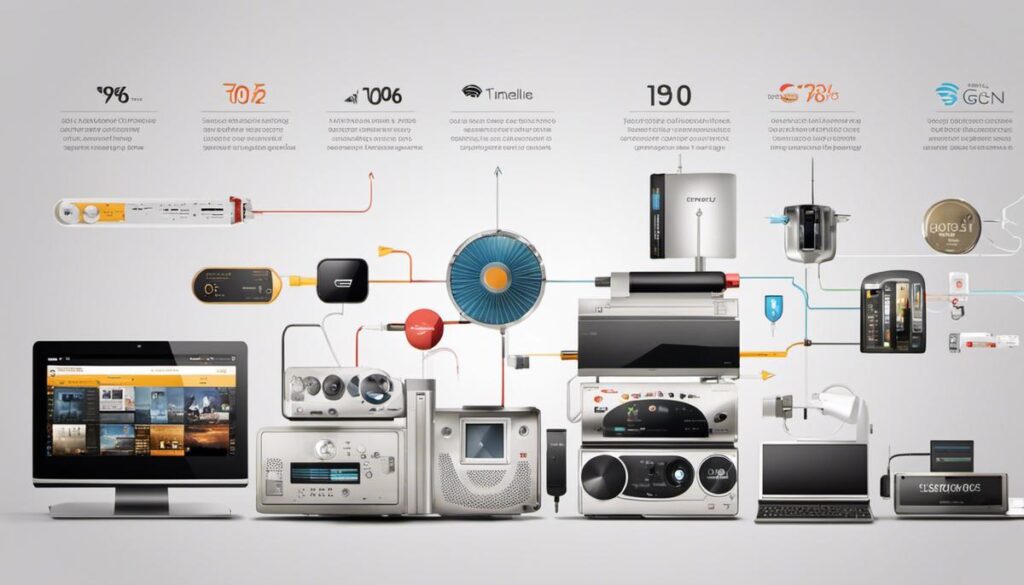Witnessing the extraordinary evolution of gadgets, from mere tools of convenience to indispensable aspects of our lives, is an invigorating journey. This fascinating progression has spanned across the course of history, with innovations and milestones shaping the contours of our personal and professional worlds. From the advent of the wheel to the creation of touch screen technology, gadgets have incessantly enhanced the human capacity to interact with the world. Predominantly, the scope of this discourse envelops the evolution of these gadgets, their current rendering in the modern era, and a prospective outlook on their future advancements.
Understanding gadget evolution
The Earliest Forms of Gadgets
The history of gadgets is a centuries-old tale, starting with simple tools used to make everyday tasks easier. The term “gadget” did not come into play until the 19th century with the industrial revolution. Simple instruments like the wheel and lever were the first gadgets that humans used. Over time, gadgets became more complex, like the mechanical clock, which was an intricate gadget of the medieval period.
The Advent of Electronics: The Foundation of Modern Gadgets
The late 19th and early 20th centuries marked a significant turning point in the evolution of gadgets with the advent of electricity and electronics. This period saw the creation of several key gadgets like the telephone, radio, television, and later the personal computer. The invention of transistor in 1947 was a breakthrough moment leading to the miniaturization of electronic gadgets, reducing their size while enhancing their capabilities.
The Era of Digital Gadgets: Computers and the Internet
The advent of computers and the internet, in the second half of the 20th century, opened up a multitude of possibilities for gadget development. Computers became increasingly smaller and more portable, leading to the creation of laptops and, ultimately, smartphones and tablets. The rise of the internet also led to the advent of many web-based gadgets and services which transformed our lives entirely.
Innovation in Communication: The Mobile Phone Revolution
The birth of mobile phones was a landmark moment in the history of gadget evolution. Starting as large, expensive units with only basic features, they have now scaled down in size and up in functionality, offering video calls, email, multimedia, and internet access. The introduction of the smartphone in 2007 marked a significant milestone that combined the functions of a personal computer, media player, and phone into one compact device.
Augmenting Reality: The Leap into Virtual and Augmented Reality
The newest frontier in gadget technology is augmented reality (AR) and virtual reality (VR). While both technologies have been around for a few decades, recent advancements have made them more accessible and prevalent. Initially used in gaming, these technologies are expanding to other areas like medical training, remote work, and personal entertainment.
Advancements in Smart Gadgets: The Internet of Things
The Internet of Things (IoT) is another significant development in the evolution of gadgets. It involves interconnecting common household devices and systems to the internet to gather, exchange, and execute data. This concept is heightening the level of automation and efficiency of everyday tasks within homes and businesses.
Wearable Gadgets: Merging Technology and Fashion
The wearable gadget market, encompassing items like smartwatches and fitness trackers, represents a large part of the current evolution of gadgets. These gadgets provide multiple functionalities, including health tracking, mobile connectivity, and even accessibility features for the elderly or those with physical challenges. The wearables market continues to grow and evolve, introducing gadgets that integrate deeper with our lives and bodies.
In the course of history, the evolution and unabating progression of gadgets have consistently revolutionized our abilities, habits, and aspects of daily living. As each stride in technology is made, so too is the complexity and usefulness of these indispensable instruments, paving the way for boundless opportunities for further reinvention.

Modern-day gadgets
Comprehending Contemporary Gadgets
By definition, gadgets are compact, easily transportable devices or applications that serve a specific, practical purpose. As technology has seen immense breakthroughs, the availability of these fascinating tools has expanded, assuming diverse forms and scales while mainly recognized for their utility and trailblazing design.
The customary set of gadgets that most people routinely tap into consists of smartphones, laptops, smartwatches, and tablets. At the same time, innovative devices like digital assistants, drones, fitness trackers, and virtual reality headsets are steadily becoming ubiquitous fixtures in numerous homes.
Purpose and Function of Modern-Day Gadgets
The scope of gadget purposes and functionality is broad and multifaceted. Mobile phones, for instance, have become more than just communication devices. They are used for browsing the internet, mobile banking, GPS tracking, and entertainment purposes, such as gaming and streaming videos. Similarly, smartwatches have now become extensions of our phones that also monitor health metrics like heart rate and sleep patterns.
Laptops are versatile tools for work, education, entertainment, and creative pursuits, while digital assistants like Amazon’s Alexa and Google Home provide hands-free assistance in everyday tasks like scheduling appointments, setting reminders, or regulating other gadgets such as lights and thermostats in smart homes.
Drones and virtual reality headsets have brought entertainment to new heights, allowing people to interact with digital and physical realms in ways that were once considered sci-fi.
Impact of Modern-Day Gadgets on Daily Lives
These gadgets can greatly influence and shape the lifestyles of their users. They have brought about a significant impact on various sectors of life, including communication, entertainment, education, health, and business.
For communication, smartphones and the internet have bridged gaps between people, regardless of distances. Similarly, in the business and educational sectors, gadgets like laptops and tablets have made work and learning more flexible and accessible.
In terms of health, gadgets like fitness trackers and smartwatches encourage their users to monitor their health metrics regularly and take charge of their personal wellness.
However, it’s also crucial to remember that like all technological advancements, gadgets pose various challenges too. Notably, dependence on these devices can create social isolation, lack of physical activity, and can trigger mental health issues such as anxiety and depression.
Additionally, privacy and security concerns are linked to the usage of these devices, as data stored and shared can potentially be accessed by malicious parties. Therefore, it’s critical to use these gadgets responsibly and ensure proper measures to safeguard personal information.
An Insight into the Unique Features of Today’s Gadgets
Technology and gadgets are ever-changing entities, always showing signs of constant evolution. Take the smartphone industry, for instance, where brands compete by emphasizing unique features such as camera excellence, lasting battery life, high processing speed, large screen size, among others to set their products apart.
This trend of highlighting distinctive features extends beyond smartphones to other gadget sectors. Consider drones equipped with high-resolution cameras, smartwatches loaded with ECG monitoring, or virtual reality headsets boasting immersive sound technologies.
In the scenario of smart homes, devices such as digital assistants are continuously upgraded, boasting higher-grade voice recognition software or integration possibilities with various smart home devices, resulting in sophisticated and far-reaching home automation systems.
These exclusive features are not just the unique selling propositions for these gadgets but are also indicative of the direction that tech innovation is propelling towards – enhancing convenience, efficiency, and an elevated user experience.

Future of gadgets
Deciphering the Future of Gadgets
Presently, gadgets, or as they are more commonly known – digital or smart devices, are experiencing swift and amplified evolution. They are increasingly shifting their essence from being merely functional to becoming essential integrations in our routine life. Primary drivers of this trend include remarkable advancements in sectors like artificial intelligence, machine learning, Internet of Things (IoT), and wireless connectivity.
Today, we see commonplace gadgets like smartphones, wearable technologies like smartwatches and fitness bands, and home automation tools like smart thermostats. While these devices have already brought significant transformations in our lives, they only preview the vast sea of changes that the future holds.
Current Technological Trends and Innovations
Artificial intelligence (AI) and machine learning (ML) have had significant impacts on gadget technology. AI/ML can process large volumes of data faster and more accurately than humans. This has led to the creation of gadgets that can predict user behavior and offer personalized recommendations.
The Internet of Things (IoT) has also played a considerable role in shaping the gadget landscape. IoT involves connecting devices to the internet to allow for automation and remote control. It has paved the way for smart homes and cities with interconnected devices that communicate with each other.
Another innovative technology defining gadgets’ future is Augmented Reality and Virtual Reality (AR/VR). These technologies can create immersive digital experiences, revolutionizing fields like gaming, education, entertainment, and healthcare.
Using 5G technology, the next generation of internet connectivity, is expected to make devices faster, more stable, and able to handle increased data – opening up a world of possibilities for smart gadgets.
Looking Into the Future of Gadgets
Future gadgets are likely to be even more integrated into our lives, with advancements focusing on improving user experience and providing seamless interconnectivity. We might see more wearable technology with health- and performance-monitoring features, context-aware devices that adjust to our behavior, and increasingly personalized experiences through AI and ML.
There’s a promise of even more advanced home automation systems that coordinate every aspect of our domestic life, from food preparation to cognitive assistance. This could extend to entire smart neighborhoods or cities that optimize resources and monitor their environment to improve residents’ lives.
Potential Benefits and Challenges
The benefits of advanced gadgets are manifold. They have the potential to improve productivity, convenience, and decision-making. They can also provide personalized services and support in numerous sectors, such as healthcare with patient monitoring, or education with personalized learning tools.
However, these advancements come with challenges. Privacy and security are major concerns as more data is collected and shared. Furthermore, the increasing reliance on digital devices might exacerbate the digital divide and contribute to increased e-waste.
Another issue is the potential for job displacement due to automation, requiring a careful examination of the socio-economic implications of future gadget technology.
Overall, while future gadgets hold immense potential to transform various aspects of our lives, it is crucial to navigate these developments responsibly and sustainably.

Precisely understanding the transformation of gadgets is essential not only to appreciate our technological achievements but also to envisage the prospects of our future. As we move forward, it is undeniable that gadgets will continue to evolve, enhancing, and in some areas redefining, human potential. As long as our curiosity fosters innovation and our challenges inspire ingenuity, the future of gadgets indeed bodes a revolution that we can barely fathom today. Therefore, keeping abreast with this rapid evolution would aid us in maximizing the potential of emerging innovations in our everyday lives, contributing effectively to our societies, and shaping a future that aligns with our shared aspirations.
Writio: AI-powered content writer for websites. This article was effortlessly crafted by Writio, your trusted AI companion.

